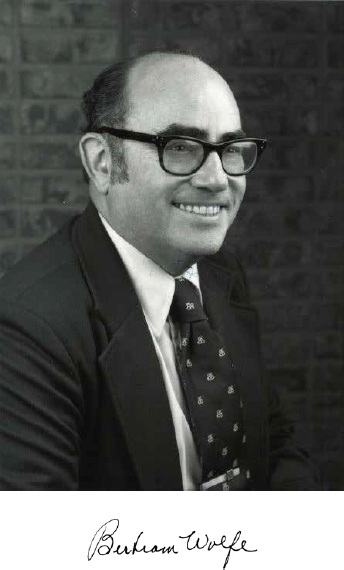He served on the Aerospace/Defense (as chair; 1986–89) and Industry Advisory Boards (1986–91) and the Committee for the 25th Anniversary of the NAE (1988–90).
In addition to his election to the NAE in 1974, Wilson was honored with numerous awards. In 1975 he received the James Forrestal Award from the National Security Industrial Association for leadership in promoting understanding and cooperation between industry and government in the interest of national security. He received the Anson Marston Medal from the College of Engineering at Iowa State University in 1978 in recognition of outstanding achievements in engineering. In 1979 he was selected for the Wright Brothers Trophy from the National Aeronautic Association (NAA) for “significant public service of enduring value to aviation in the United States,” and Financial World named him chief executive officer of the year for bringing Boeing back from the depths to a state of prosperity.
In 1982 the NAA’s Collier Trophy was awarded to Wilson and Boeing “for the private development of two advanced technology transports—757 and 767—with the support of the Federal Aviation Administration, industry, and the airlines.” In 1983 Wilson was enshrined in the National Aviation Hall of Fame for engineering and managerial achievements during his career with Boeing. Also in 1983 he was named Seattle’s “First Citizen” by the Seattle/King County Board of Realtors for his meritorious accomplishments in civic, community, and public service. In 1985 he received both the National Academy of Sciences Award in Aeronautical Engineering and the Daniel Guggenheim Medal, and the following year he was selected for the Wings Club Distinguished Achievement Award. In 1987 the Museum of Flight in Seattle named a newly constructed glass gallery after Wilson, who led the original funding effort to construct the 143,000-square-foot glass and steel showcase. In February 1989 he was inducted into the National Business Hall of Fame.
He was survived by his wife, Grace (née Miller); children Thornton A. Wilson 3rd of Seattle, Daniel A. Wilson of Newcastle, Washington, and Sarah W. Parkinson of Enumclaw, WA; and six grandchildren.

BERTRAM WOLFE
1927–2004
Elected in 1980
“Contributions to the development of advanced nuclear concepts and projects, particularly fast flux reactors.”
BERTRAM WOLFE, a significant contributor to nuclear power development and its success, died September 6, 2004, in Los Gatos, California, at age 77. He was an industry spokesman on nuclear power and energy needs and an excellent debater willing to take on all critics. He was a leader who strongly pushed fast reactors and their ability to save energy resources. It is unfortunate that he was not able to participate in the attention that reactors finally received.
He was born June 26, 1927, in the Bronx, New York. He received his BA in physics from Princeton University in 1950 and his PhD in nuclear physics from Cornell University in 1954. He joined General Electric Company in 1955, when its commercial nuclear energy business was initiated, and worked in almost all phases of nuclear energy, from reactor design to fuel supply, waste management, and development of new reactor concepts.
During the 1950s and 1960s he led the nuclear core design effort on several new test and research reactors, including the engineering test reactor, the GE test reactor, and the radiation effects reactor. He was responsible for the Southwest Experimental Fast Oxide Reactor (SEFOR) project, which demonstrated the inherent shutdown characteristics of a fast reactor under accident conditions.
In 1969 he briefly left GE to be associate director of Battelle Northwest Laboratories, with broad responsibilities including design and development efforts for the fast flux test reactor. In 1971 he returned to GE, where he led the successful decommissioning of the Shippingport (PA) reactor and the completion of the Morris (IL) reprocessing plant. The direction of this latter activity was changed when new government policies outlawed reprocessing in the United States. The Morris plant was efficiently converted to a spent-fuel storage facility that is still in operation.
Dr. Wolfe was also responsible for the continued development of the fast breeder reactor and led the effort that resulted in GE’s selection as the lead organization for the US Fast Breeder Development Program.
In the late 1970s, when the market for new reactors faded, he was given responsibility for the GE nuclear fuel supply and services business to support the operating nuclear plants. This responsibility included developing and meeting both technical and business objectives. He was also responsible for the GE advanced reactor program, which culminated in the start of construction of two advanced boiling water reactors at the Kashiwasaki site in Japan.
Beginning in 1987 he headed GE’s Nuclear Energy business as vice president and general manager. He played a key role in bringing it to a profitable position. He retired from GE in August 1992 at age 65.
A professional engineer in the state of California, Dr. Wolfe became an independent consultant in the fields of nuclear energy and energy services. He held several patents in the nuclear field and was the author of over 100 publications concerning nuclear technology, nuclear energy, and energy in general.
He was professionally engaged in a number of organizations. He was a director of Houston Lighting and Power and served on the Nuclear Advisory Board of Pennsylvania Power and Light, International Advisory Committee of Concord Industries, and several other advisory boards as well as the Energy Engineering Board (1987–93) of the National Research




